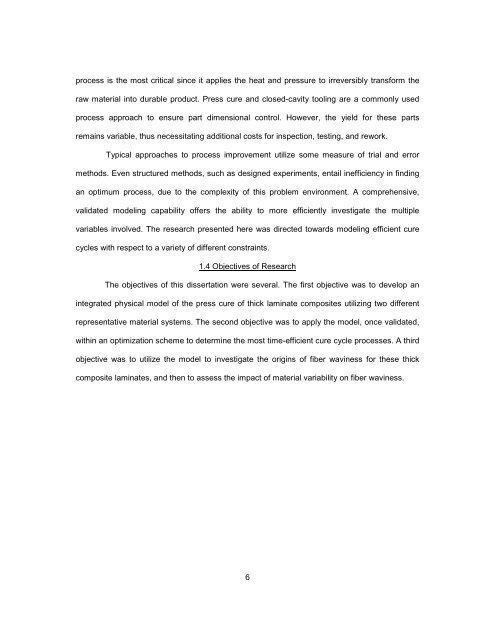TOOLED THICK COMPOSITES by ARVEN H. SAUNDERS III ...
TOOLED THICK COMPOSITES by ARVEN H. SAUNDERS III ...
TOOLED THICK COMPOSITES by ARVEN H. SAUNDERS III ...
You also want an ePaper? Increase the reach of your titles
YUMPU automatically turns print PDFs into web optimized ePapers that Google loves.
process is the most critical since it applies the heat and pressure to irreversibly transform the<br />
raw material into durable product. Press cure and closed-cavity tooling are a commonly used<br />
process approach to ensure part dimensional control. However, the yield for these parts<br />
remains variable, thus necessitating additional costs for inspection, testing, and rework.<br />
Typical approaches to process improvement utilize some measure of trial and error<br />
methods. Even structured methods, such as designed experiments, entail inefficiency in finding<br />
an optimum process, due to the complexity of this problem environment. A comprehensive,<br />
validated modeling capability offers the ability to more efficiently investigate the multiple<br />
variables involved. The research presented here was directed towards modeling efficient cure<br />
cycles with respect to a variety of different constraints.<br />
1.4 Objectives of Research<br />
The objectives of this dissertation were several. The first objective was to develop an<br />
integrated physical model of the press cure of thick laminate composites utilizing two different<br />
representative material systems. The second objective was to apply the model, once validated,<br />
within an optimization scheme to determine the most time-efficient cure cycle processes. A third<br />
objective was to utilize the model to investigate the origins of fiber waviness for these thick<br />
composite laminates, and then to assess the impact of material variability on fiber waviness.<br />
6
















